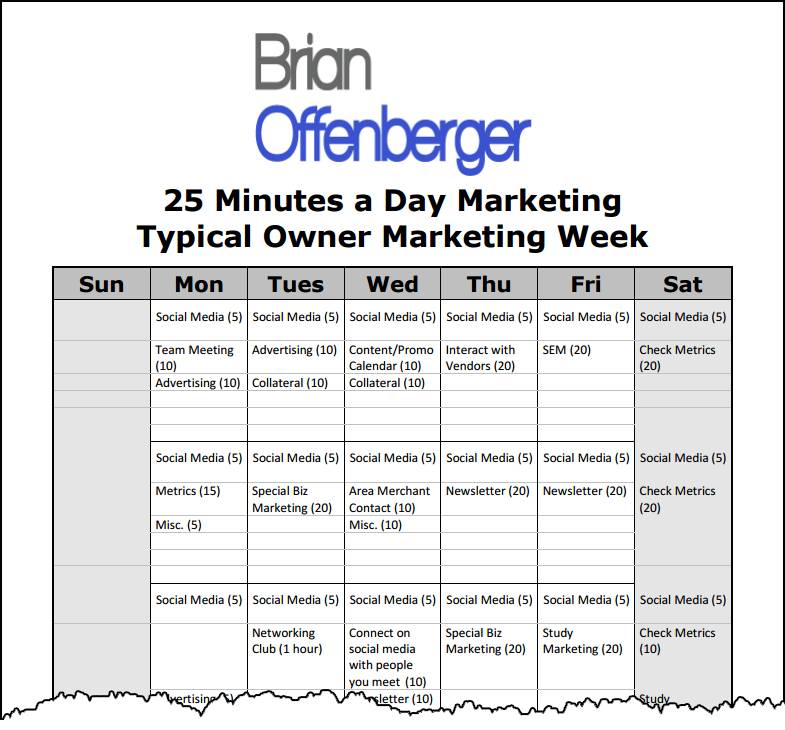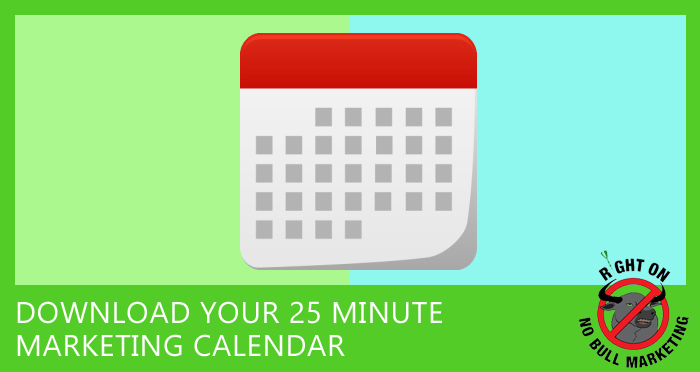 So you run a small business and continually struggle to find the time to market and advertise your business.
So you run a small business and continually struggle to find the time to market and advertise your business.
That is a common problem.
I’ve been helping small business owners generate more leads and make more sales since the 1980s. I’ve seen the struggles small business owners face in finding time for marketing and, through lots of trial and error, have developed an effective roadmap small business owners can follow for marketing success.
At the end of this article, you’ll be able to download The 25 Minute Marketing Calendar. It shows in a day by day, action by action fashion exactly what you should do and when you should do it for marketing success.
Before sharing the calendar, you need to know some basic tips to take control of your schedule and your day…
What is the Difference Between Urgent and Vital Activities?
Most activities faced by a small business owner can fall into one of two categories:
- Urgent activities are those we believe demand immediate attention. Urgent activities are usually associated with achieving someone else’s goals, not yours. Small business owners generally concentrate on urgent activities because they believe these activities demand immediate attention.
- Vital activities have outcomes that help us achieve our goals.
Most small business owners spend too much time on urgent activities and not enough time on vital ones.
General Dwight Eisenhower shed light on this issue way back in 1954 when he said, “I have two kinds of problems: the urgent and the important. The urgent are not important, and the important are never urgent.” This belief has grown to be known as “The Eisenhower Principle.”

Let’s use our health as an example. Our goal is to be healthy. All of us know that exercise is VITAL to our overall health and well-being. Yet how many of us exercise daily? Although we know exercise to be vital to our overall health, it’s not urgent that it be done today. We tell ourselves that other things are more urgent. So what happens? Most of us push exercise off until tomorrow, and then the next day and then the next day. The result? We’re fat, sick and unhealthy.
By properly identifying which things are “urgent” and which are “vital,” we can better manage our natural tendency to do the urgent and instead spend more time focusing on the vital.
How to Identify Urgent and Vital Activities
There is a basic matrix I like to use to help business owners classify the activities they spend time on. See it below:
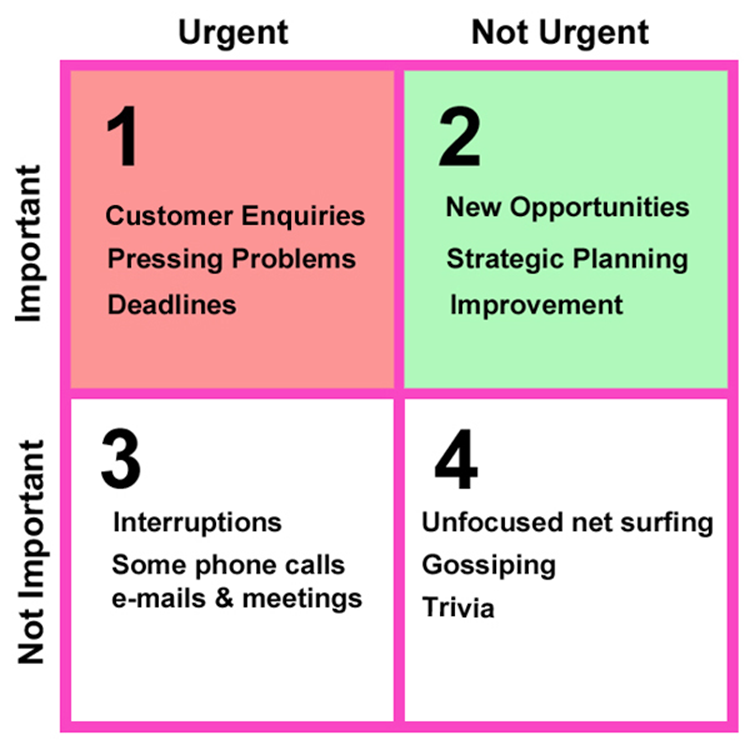
So now that you’ve properly classified your activities, how should we handle them? Again, there is another matrix you’ll find useful. I found it on a post by Diana S. Khoury on LinkedIn. It does a great job of showing what to do with each of the four activity areas:
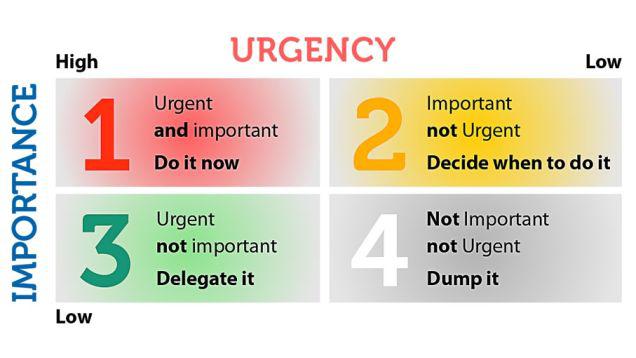
Take Control of Your Day
There are some other actions you should take to help you focus more on vital activities:
1. Phone and Email
Don’t be a prisoner to the telephone and email.
Think about this for a minute. Too many business owners I’ve worked with feel they need to respond to every email as it comes in, and answer the phone every time it rings.
Who’s in control when that happens?
You don’t run to the mailbox 10 times a day to see if you have mail. You don’t wash every dish as it’s used… you put it in the dishwasher so you can clean many of them all at one time.
Why not take that approach with phone calls and email?
Select two times a day that you’ll make phone calls and manage email. You’ll be more effective and more efficient.
2. Employees
It’s easy for employees to interrupt small business owners. Some of these interruptions are necessary and important. Too often though, they simply distract us and move us further away from our goals.
Here are two tips to help avoid employee interruptions: schedule office hours and teach employees Dale Carnegie’s five quick steps for solving business problems.

Office hours are times you are available to employees to meet about business processes, employee interests and things of importance to the employee. Let employees know your availability and make sure you follow through and keep the office hours you publish.
Dale Carnegie’s five step problem solving process helps employees solve business issues without your involvement. The five steps are:
- Define clearly the problem or issue.
- Define the root cause (s) of the problem.
- Identify the possible solutions to the problem.
- Select the best possible solution.
- Decide a course of action.
Learn more about this process at http://westernct.dalecarnegie.com/5_quick_steps_for_solving_business_problems/. The more effective your employees are at successfully solving challenges and issues, the more time you’ll have to handle vital activities.
3. Meetings

Before scheduling a meeting or agreeing to attend a meeting, ask yourself three simple questions:
- Can this be done another way?
- What’s the purpose?
- What’s the cost?
Many meetings are unnecessary. Asking yourself these three questions help you think about the merits of a meeting.
Should a meeting be absolutely necessary, then make sure they are an efficient use of time. Some of my favorite tips for effective and time efficient meetings include:
- Have a meeting agenda and distribute it to all attendees prior to the meeting.
- Start on time…no late starts. Set the proper tone that you’ll be efficient with time.
- Hold stand up meetings, don’t let people sit down. This keeps attendees focused and helps minimize long winded deviations from the agenda.
- Ban mobile devices and laptops…keep attendees focused on the meeting content.
Tips to Prioritize Your Activities
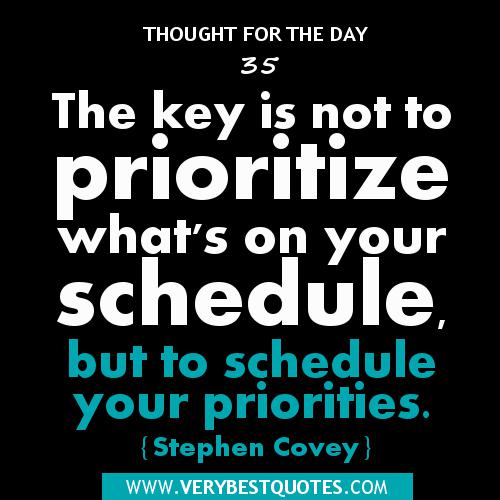
How do you prioritize the demands on your time to yield the maximum return? I teach small business owners these four concepts:
1. Which activities are closest to your profit line? You are in business to have fun and to make a profit. Spend your time on the activities that make you money.

2. What are your goals? Spend your time on activities that lead to the achievement of your goals.
3. What is your marketing plan? A marketing plan is your roadmap for your organization’s overall marketing efforts. Prioritize your activities based upon their importance to your overall marketing plan.

4. Use a promotional calendar. Too many small business owners plan marketing and promotional activities by the seat of their pants. They decide they need to do something, and then they scramble to make that “something” happen. Marketing and advertising for these types of business owners is an event rather than a process in their business. And because we need ongoing marketing and advertising activities to help us succeed, an event driven approach makes it harder to achieve optimal results.
A better approach is to use a promotional calendar. A promotional calendar outlines marketing and sales activities over a 6, 12, or 18 month period. It allows a business to have a master plan for marketing and promotions, and it eliminates the “seat of the pants” approach used by many. Here are 13 tips you can follow to create effective promotional calendars.

The 25 Minutes a Day Marketing Calendar
Download a copy of the 25 Minutes a Day Marketing Calendar here.
To develop an effective marketing calendar, it’s important to make a list of all the marketing and advertising activities you must do. Then, determine the amount of time necessary for each activity and when it should be done.
It’s also important to understand how to measure impacts and how to define success. There are 12 common metrics I recommend for tracking and analysis by small business owners. You can see them listed on the slide below from my presentation at Auto Glass Week 2015.
![]()
To use the calendar properly you need a list of terms used on it, and what each means:
- Social media means that you check your social media accounts and take appropriate action as needed.
- Team meeting is a group gathering of your employees to inform them about promotions and happenings.
- Advertising is the time you spend on advertising related work and issues.
- Collateral refers to the development or collection of media to support advertising and sales of a product or service. This includes things like ad copy, signage, sales flyers, etc.
- Content/promo calendar refers to activities relating to your promotional planning and execution.
- Interact with vendors refers to your time needed to interact with marketing partners, like ad reps and webmasters.
- SEM means search engine marketing activities, things like link building, directory listings, reputation management and content publication.
- Check metrics is the time you spend calculating and evaluating key performance indicators.
- Special Biz Marketing relates to new market development or joint venture marketing opportunities.
- Area merchant contact involves networking with other businesses to increase the sales at yours. As an example, if I own a sandwich shop I may offer a discount to area merchants to share with their employees.
- Newsletter refers to the development time you need to generate and send communications to your existing and potential customers.
- Networking clubs like BNI groups, Mastermind clubs, chambers of commerce or merchant’s associations are great sources of new business.
- Study marketing relates to the time you spend learning more about marketing so you generate more sales and profits.
- Joint venture marketing refers to specific activities you take to co-promote your business with others. Learn more about this practice at http://smallbusiness.chron.com/joint-venture-marketing-30933.html.
- Misc. is a time allocation for things you need to do that either aren’t on the calendar or you need more time to accomplish.
Here’s a 25 Minute a Day Marketing Calendar for you to follow. It shows the activity and the number of minutes you should spend on each activity. Click on the image below for a PDF copy on the entire 25 Minute Marketing Chart.
Brian Offenberger is a top-rated marketing and sales trainer whose radio show about online marketing was voted by marketing pros as one of the world’s top sources for online marketing best practices. Brian’s ideas have been featured by the New York Daily News and more than 100 publications. He is a marketing and sales strategist whose company develops websites and generates leads using blogging, social media, online advertising, email and inbound marketing. Connect with Brian on LinkedIn at https://www.linkedin.com/in/brianoffenberger.


